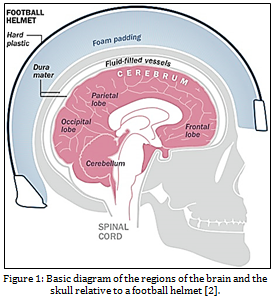
Inside the skull, the brain is protected by a layer of cerebral spinal fluid (Figure 1). This fluid serves as a cushion or shock absorber to protect the brain from most injuries that occur in normal life; it is only when excessively large or sudden forces are exerted that this system fails. Such a failure usually results in the brain striking against the skull in one or more places, which can result in bruising of brain tissue and excessive strain to connective tissues in the central nervous system [1]. The long-term consequence of such brain trauma may be physical problems such as headaches and nausea, cognitive issues such as memory loss, and emotional or behavioral changes.
As shown in Figure 2, the frontal and occipital lobes are the areas of the brain which are most injured in linear impact. This is due to the linear forces causing the brain to strike the front of the skull initially, and then bounce back and strike the back of the skull secondarily. Usually, the forces in a linear impact cause twisting and breakage in the  axons of brain cells. This causes brain swelling and places stress on the brain stem, leading to long-term damage to the central nervous system. It is possible that the player may never recover, and will have to live with such brain trauma for the rest of their life [4]. With this in mind, the purpose of this project is to design a better football helmet which will protect against concussions for the ultimate safety and well-being of the players involved.
axons of brain cells. This causes brain swelling and places stress on the brain stem, leading to long-term damage to the central nervous system. It is possible that the player may never recover, and will have to live with such brain trauma for the rest of their life [4]. With this in mind, the purpose of this project is to design a better football helmet which will protect against concussions for the ultimate safety and well-being of the players involved.
[1] S. Chrisman, M. Schiff, S. Chung, S. Herring and F. Rivara, ‘Implementation of Concussion Legislation and Extent of Concussion Education for Athletes, Parents, and Coaches in Washington State’, The American Journal of Sports Medicine, vol. 42, no. 5, pp. 1190-1196, 2014
[2] TIME Magazine, Concussion Physics. 2015.
[3] E. Blackman, ‘Helmet Protection against Traumatic Brain Injury: A Physics Perspective’, 2015.
[4] A. McKee, et. al., ‘Chronic Traumatic Encephalopathy in Athletes’, Journal of Neuropathology and Experimental Neurology, vol. 68, no. 7, pp. 709-735, 2009
Speak your mind